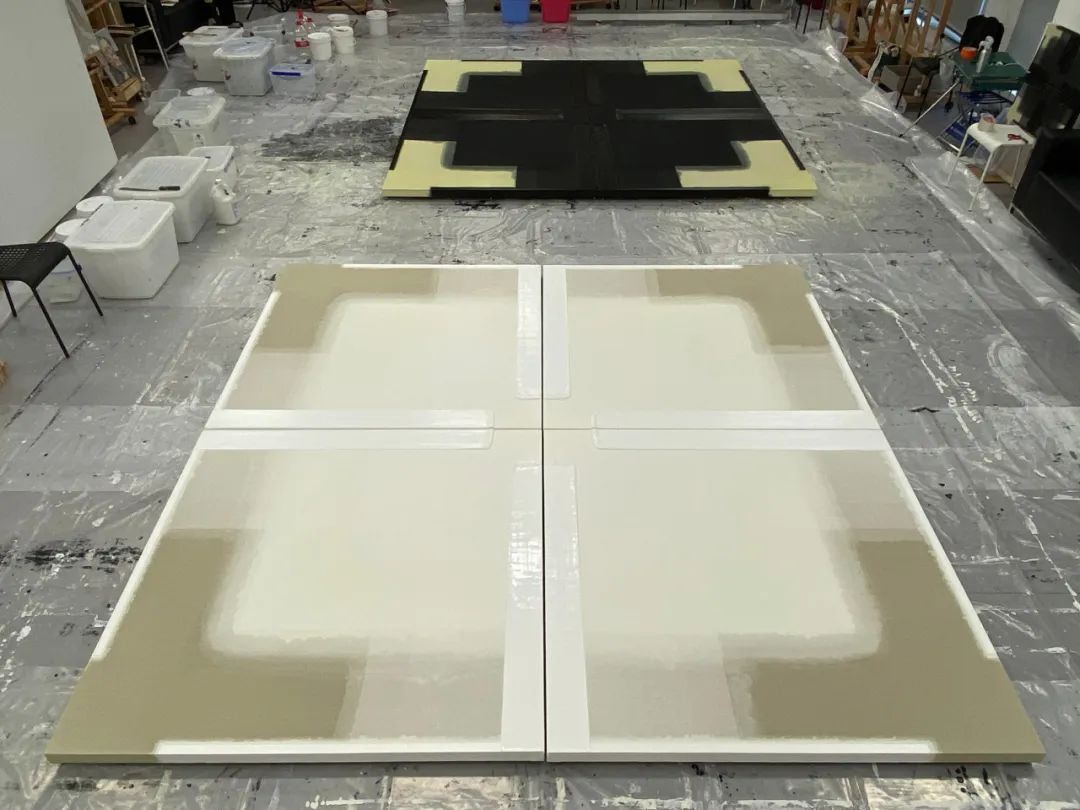
As a Joseonjok artist from Yanbian, China, Jin Rilong's early creations depict much realistic life status of ethnic minorities and symbolic portraits. In recent years, he has been using abstract expressions to focus on the spiritual world of human beings. When viewers look deep into it, he could truly perceive a universal reflection on the human status quo under the construction of modernity.
 Jin Rilong's artworks during the creation
Jin Rilong's artworks during the creation
For Jin Rilong, who creates daily in the studio, the creative space has never largely changed during the COVID-19 outbreak. However, the current environment and atmosphere bring him different emotions and ideas. Under the influence of the pandemic situation, the artist's aura has undergone a subtle change. Under the impetus of the brand new aura, Jin Rilong naturally revealed more in-depth problems and experiences through his works. What exactly does his conceptual painting convey to viewers? Emotion, reflection, or an open chaotic state? The confusion of viewers is an ingenious metaphor of knowledge dilemma and the multiple choices of value judgment in the information era.
 Jin Rilong's artworks during the creation
Jin Rilong's artworks during the creation
The shift in the focus of Jin Rilong's artistic creation not only reflected the development trend of Western art history from realism to abstraction but also witnessed the formation and development of Chinese abstract painting discourses, telling how conceptual expression finally surpasses the artistic exploration habits of visual language and formal aesthetics. Jin Rilong's artwork is no longer shackled in the function of life records, but instead incorporates macroscopic attitudes and feelings towards the world.

Baraka,2019
Acrylic on Canvas
80 x 161 cm
Jin Rilong once said: "Actually, either figurative or abstract is an artificially given definition." Something may be constantly changing, but something will stay still forever. When talking about what is never changing, he confessed that "Expressing spirits have never been changed. In the past, we used oil paintings, pens, and later digital media as materials. They are different from texts because there is something that cannot be expressed by texts. Expressing the spiritual world by languages beyond the texts is never changing. "

Jin Rilong with Baraka1, 2019
Acrylic on Canvas
300 x 300 cm
Jin Rilong started his Baraka series since 2019. The method of dividing the picture is the language and form that he have consistently used in the image installation. The form of this split picture continues into all of his later works.

Baraka-diary 1, 2019
Acrylic on Canvas
50 x 102 cm
“The sky was black and the earth was yellow, The universe was vast and a dark whole.” originated from the Pre-Qin Dynasty Chinese masterpiece “The Book of Changes”, which symbolizes the ancient oriental philosophy. It contains ancient Chinese cognition of objects, universe, and space and time. It is a chaotic scene when the sky and earth appear at the very beginning. At such a special time nowadays, Jin Rilong conveyed the concept once again in his recent works. The painting itself could be seen as a diary of his during the pandemic period. Facing the crushing, reconstruction, and all back to zeros in the world, does this philosophical phrase have some new meanings?

2020.2.22
Acrylic on canvas
61 x 61 cm
About his recent artwork 2020.2.22, he said: "During the pandemic, I thought a lot, including the problems of the earth, environmental protection, and human beings. The entire earth is truly a community that every single part is inseparable. The unpredictable "Novel Coronavirus Pneumonia" interrupted our routine of work and life. 1.4 billion people were isolated at home to prevent and control the pandemic during the Chinese New Year. For me, over more than 30 years, my schedule of regular visits to my teacher has also been canceled. I can only dial him a phone call at home. On February 22, it was the day of my birthday. My family reminded me from abroad to eat 'Long-life noodles'."

2020.2.2.
Acrylic on canvas
61 x 61 cm
From the outbreak of COVID-19 back to February till now, the year of 2020 might have already become a symbolic sign which signifying a series of painful reflection. In the eyes of the artist, this is a kind of sign. Under the countless "isolated spaces", we are more soberly aware that every life form of nature is precious and irreplaceable, and we coexist with each other. The interplay of black and white echoes the silent thought of life.

Interior Image of Jin Rilong's recent artworks
About Jin Rilong
Jin is an artist from Yanbian Korean Autonomous Prefecture in Jilin Province. 1982, he attained Gold Award in the First National Exhibition of Minority Fine Arts with his work "Grandma" and shot to fame. After investigating the national traditional art treasure, the Dunhuang Grottoes murals, he decided to explore the expressiveness of painting. He created oil paintings that have a sense of music and a style of freehand brushwork and attracted more attention. Jin taught and got a doctoral degree in two art institutes in Korea in 1996. With broader exposure to modern art, he began to further explore the formal aesthetics in painting, including the use of acrylic to present the richness of color, strokes, and texture, the more implicit and abstract language, and the more delicate, subtle feeling that has inherent culture meaning. On this basis, he moved forward to the mixed media and installation art, worked in the field of modern design art, pursued contemporaneity, and showed his international vision and varieties of skills. Jin is a professor and doctoral advisor at the Central Academy of Fine Art now.
Courtesy of the artist and Amanda Wei Gallery, for further information please visit https://amandaweigallery.com.




























